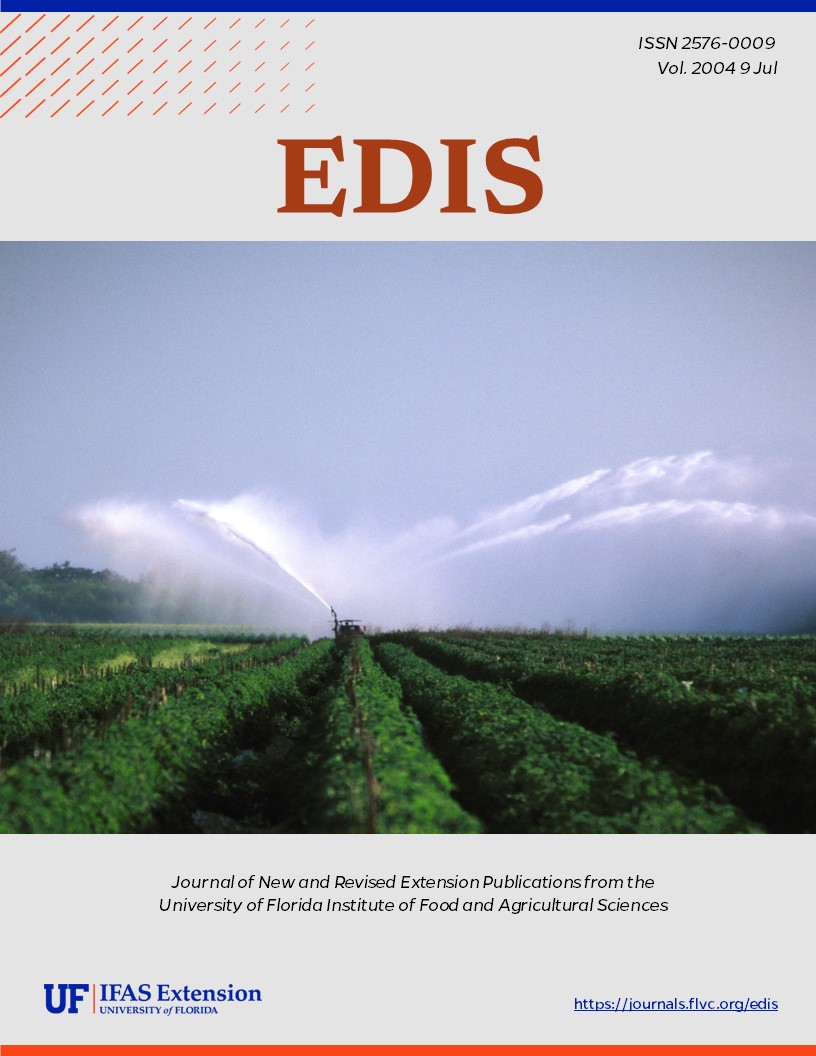Abstract
Reniform nematodes in the genus Rotylenchulus are semiendoparasitic (partially inside roots) species in which the females penetrate the root cortex, establish a permanent-feeding site in the stele region of the root and become sedentary or immobile. The anterior portion (head region) of the body remains embedded in the root whereas the posterior portion (tail region) protrudes from the root surface and swells during maturation. The term 'reniform' refers to the kidney-shaped body of the mature female. There are ten species in the genus Rotylenchulus. Rotylenchulus reniformis is the most economically important species (Robinson 1997 ) and is called the reniform nematode. This document is EENY-210, one of a series of Featured Creatures from the Entomology and Nematology Department, Florida Cooperative Extension Service, Institute of Food and Agricultural Sciences, University of Florida. Published: May 2001.
References
Apt W Jr. 1976. Survival of reniform nematode in desiccated soils. Journal of Nematology 8: 278 (Abstract).
Apt W J, Caswell EP. 1988. Application of nematicides via drip irrigation. Annals of Applied Nematology 2: 1-10.
Ayala A, Ramirez CT. 1964. Host-range, distribution, and bibliography of the reniform nematode, Rotylenchulus reniformis, with special reference to Puerto Rico. Journal of Agriculture of University of Puerto Rico 48: 140-160. https://doi.org/10.46429/jaupr.v48i2.12985
Balasubramanian P, Ramakrishnan C. 1983. Resistance to the reniform nematode Rotylenchulus reniformis in tomato. Nematologia Mediterranea 11: 203-204.
Caswell EP, deFrank J, Apt WJ, Tang C-S. 1991. Influence of nonhost plants on population decline of Rotylenchulus reniformis. Journal of Nematology 23: 91-98.
Inserra RN, Dunn RA, McSorley R, Langdon KR, Richmer AY. 1989. Weed hosts of Rotylenchulus reniformis in ornamental nurseries of southern Florida. Nematology Circular No. 258. Florida Department of Agriculture and Consumer Services, Division of Plant Industry, Gainesville.
Inserra RN, Dunn RA, Volvas N. 1994a. Host response of ornamental palms to Rotylenchulus reniformis in Florida. Supplement to the Journal of Nematology 26: 737-743.
Inserra RN, Lehman PS, Overstreet C. 1994b Ornamental hosts of the reniform nematode, Rotylenchulus reniformis. Nematology Circular No. 209. Florida Department of Agriculture and Consumer Services, Division of Plant Industry, Gainesville.
Kinloch RA, Sprenkel RK. 1994. Plant-parasitic nematodes associated with cotton in Florida. Journal of Nematology 26: 749-752.
Linford MB, Oliveira JM. 1940. Rotylenchulus reniformis, nov. gen. n. sp., a nematode parasite of roots. Proceeding of the Helminthological Society of Washington 7: 35-42.
Mai WF, Mullin PG. 1996. Plant parasitic nematode. A Pictorial Key to Genera, 5th Ed. Cornell University Press, Ithaca, New York. https://doi.org/10.7591/9781501728419
McSorley R. 1980. Nematodes associated with sweetpotato and edible aroids in southern Florida. Proceedings of Florida State Horticultural Society 93: 283-285.
McSorley R, Campbell CW, Parrado JL. 1982. Nematodes associated with tropical and subtropical fruit trees in south Florida. Proceedings of Florida State Horticultural Society 95: 132-135.
McSorley R, Parrado JL, Stall WM. 1981. Aspects of nematode control on snapbean with emphasis on the relationship between nematode density and damage. Proceedings of Florida State Horticulture Society 94: 134-136.
McSorley R, Parrado JL, Conover RA. 1983. Population buildup and effects of the reniform nematode on papaya in southern Florida. Proceedings of Florida State Horticultural Society 96: 198- 200.
Radewald JD, Takeshita G. 1964. Desiccation studies on five species of plant-parasitic nematodes of Hawaii. Phytopathology 54: 903-904.
Rebois RV, Epps JM, Hartwig EE. 1970. Correlation of resistance in soybeans to Heterodera glycines and Rotylenchulus reniformis. Phytopathology 60: 695-700. https://doi.org/10.1094/Phyto-60-695
Robinson AF, Inserra RN, Caswell-Chen EP, Vovlas N, Troccoli A. 1997. Rotylenchulus species: Identification, distribution, host ranges, and crop plant resistance. Nematropica 27: 127-180.
Roman J. 1964. Immunity of sugarcane to the reniform nematode. Journal of Agriculture, University of Pueto Rico 48: 162-163. https://doi.org/10.46429/jaupr.v48i2.12986
Sipes BS, Schmitt DP. 2000. Rotylenchulus reniformis damage thresholds on pineapple. Acta Horticulturae 529: 239-245. https://doi.org/10.17660/ActaHortic.2000.529.29
Starr JL, Page SL. 1990. Nematode parasites of cotton and other tropical fiber crops. pp. 539-556. In: Plant parasitic nematodes in subtropical and tropical agriculture. Luc M, Sikora RA, Bridge J (eds). CAB International, Oxon, UK.
Unless otherwise specified, articles published in the EDIS journal after January 1, 2024 are licensed under a Creative Commons Attribution-NonCommercial-NoDerivs 4.0 International (CC BY-NC-ND 4.0) license.

